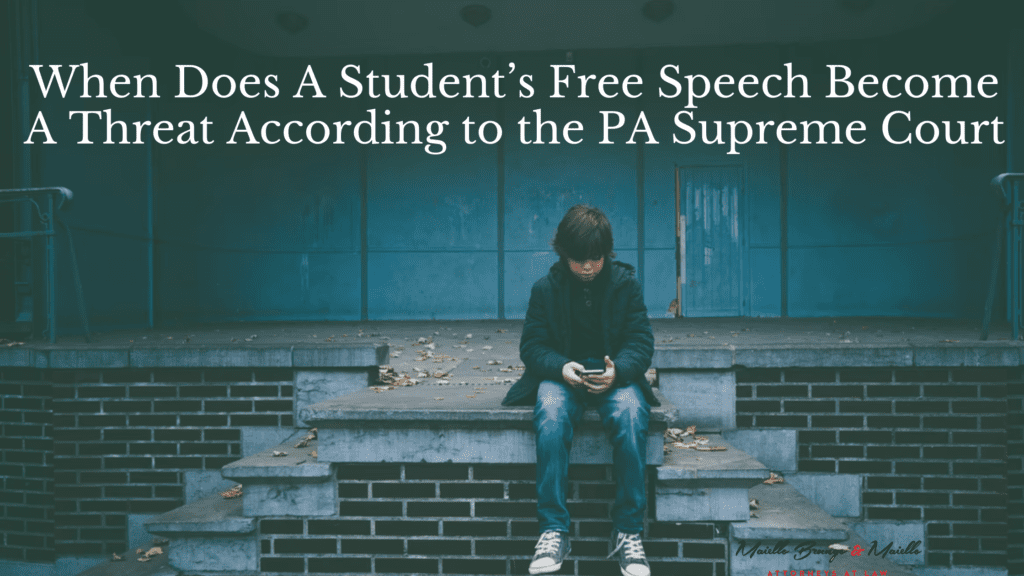J.S. v. Manheim Township School District
Recently, the Pennsylvania Supreme Court decided the case of J.S. v. Manheim Township School District that addressed the limitations on a school district’s ability to expel a student for creating a private social media communication which, in the School District’s opinion, constituted a threat to school safety. In early April of 2018, J.S. and another student, identified as Student 1 in the Opinion, engaged in conversations on social media during which both J.S. and Student 1 made fun of another classmate, identified as Student 2 in the Opinion, suggesting that Student 2 looked like a school shooter. On April 10, 2018, J.S. sent Student 1 several Snapchat photos in which J.S. created an image of Student 2 singing into a microphone with a text overlay containing violent lyrics referencing a school shooting. J.S. also created a short video which depicted Student 2 playing a guitar with a text caption overlay referencing that Student 2 would eat Student 1. Both of these postings were sent directly to Student 1 and were intended to be private. Subsequently, Student 1 posted J.S.’s images to his personal Snapchat account where they could be viewed by other students. Other students viewed the images with the textual overlays and reported them to school officials. Ultimately, the school officials expelled J.S. for making terroristic threats. J.S. appealed his expulsion to the Court of Common Pleas, which overturned the expulsion. The Commonwealth Court upheld the decision of the Court of Common Pleas and the School District appealed to the Pennsylvania Supreme Court.
The Pennsylvania Supreme Court first engaged in a lengthy analysis of prior decisions pertaining to the First Amendment Speech Protections in school settings. The Court focused on the “true threat” exception to the First Amendment which is defined as a communication that a speaker intended to be a serious expression of an attempt to inflict harm. The Pennsylvania Supreme Court concluded that the United States Supreme Court has not yet developed a comprehensive test detailing what constitutes a true threat. Therefore, the State Supreme Court analyzed cases from lower federal courts and state courts to attempt to formulate more definite factors to determine whether a student’s speech constitutes a true threat and removes it from the protection of the First Amendment.
Contextual Factors in PA Supreme Court Case to Determine if a Student’s Free Speech is a Threat to Safety
The Supreme Court created a two-part inquiry which requires a school to first examine the content of the speech and then assess relevant contextual factors surrounding the speech. Those factors include, but are not limited to:
- The language employed by the speaker,
- Whether the statement constituted political hyperbole jest, or satire,
- Whether the speech was of the type that often involves inexact and abusive language,
- Whether the threat was conditional,
- Whether it was communicated directly to the victim,
- Whether the victim had reason to believe the speaker had a propensity to engage in violence, and
- How the listeners reacted to the speech.
In analyzing the factual background of the J.S. case against this two-part inquiry, the Court found that, under the totality of the circumstances, J.S.’s social media postings did not rise to the level of a true threat. As the Court stated, “the actual words employed…read in isolation plainly suggested a school shooting and violence, the images viewed in totality did not threaten Student 1 or anyone else, but offered only J.S.’s opinion that Student 2 was a potential school shooter.” The Court further found the fact that the images were intended to be shared only between J.S. and Student 1 (they were sent by J.S. using his personal phone from his home), that the images did not constitute political hyperbole, but rather ridiculed a fellow student, and that there was no indirect or even implied victim counseled against finding an intent to threaten on J.S.’s part.
Supreme Court two-part inquiry examining content of speech and relevant contextual factors
Student Free Speech in Schools Under Tinker v Des Moines Decision
The Court went on to state that although it already concluded that the images created by J.S. did not constitute true threats, the inquiry was not ended. As the Court stated, even if not a true threat, a school may regulate speech and punish a student under Tinker v. Des Moines Independent Community School District for speech that causes or foreseeably could cause a substantial disruption to the school environment. The Court concluded that any disruption to the school environment in the J.S. case was caused by the School’s reaction to J.S.’s social media postings and not because of the postings themselves. Accordingly, the Supreme Court upheld the decisions of the lower courts and overturned J.S.’s expulsion.
Determination of Threatening Speech in School
The Supreme Court’s ruling in J.S. provides a roadmap for the school districts to determine whether or not it is appropriate to impose discipline against students for perceived threats against individuals in the school district. School districts must analyze the totality of the circumstances and take into account the subjective intent of the student making the speech rather than simply looking at the potential harmful threats in a vacuum.
The professionals at Maiello Brungo & Maiello specialize in assisting school districts with concerns and issues regarding social media and first amendment speech protections. Our education attorneys can assist your school district in determining whether or not its disciplinary decisions will survive review by a court before the ultimate decision is made. This will save your district time and money while also avoiding a potential embarrassing scenario.
Call us at 412-242-4400 or Contact Us
Supreme Court two-part inquiry examining content of speech and relevant contextual factors


